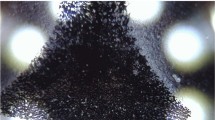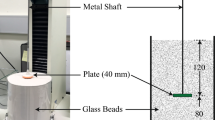Abstract.
We make time resolved velocity measurements of steel spheres in free fall through liquid using a continuous ultrasound technique. We explore two different ways to induce large changes in drag on the spheres: 1) a small quantity of viscoelastic polymer added to water and 2) altering the surface of the sphere. Low concentration polymer solutions and/or a pattern of grooves in the sphere surface induce an early drag crisis, which may reduce drag by more than 50% compared to smooth spheres in pure water. On the other hand, random surface roughness and/or high concentration polymer solutions reduce drag progressively and suppress the drag crisis. We also present a qualititative argument which ties the drag reduction observed in low concentration polymer solutions to the Weissenberg number and normal stress difference.
Similar content being viewed by others
References
J.L. Lumley, Ann. Rev. Fluid Mech. 1, 367 (1969)
N.S. Berman, Ann. Rev. Fluid Mech. 10, 47 (1978)
B.A. Toms, Proc. Int. Congress. Rheology Amsterdam, Vol. 2 (North-Holland, Amsterdam 1949) p. 135
M. Vlachogiannis, T.J. Hanratty, Exp. Fluids 36, 685 (2004)
H.L. Petrie, S. Deutsch, T.A. Brungart, A.A. Fontaine, Exp. Fluids 35, 8 (2003)
E. Achenbach, J. Fluid Mech. 54, 565 (1972)
S. Taneda, J. Fluid Mech. 85, 187 (1978)
T. Maxworthy, Trans. ASME, J. App. Mech. 36, 598 (1969)
G. Constantinescu, K. Squires, Phys. Fluids 16, 1449 (2004)
M.A. Ruszczycky, Nature 206, 614 (1965)
D.A. White, Nature 212, 277 (1966)
A. White, Nature 216, 995 (1967)
K. Watanabe, H. Kui, I. Motosu, Rheol. Acta 37, 328 (1998)
T. Sarpkaya, P.G. Rainey, R.E. Kell, J. Fluid Mech. 57, 177 (1973)
A. White, Nature 211, 1390 (1966)
E. Achenbach, J. Fluid Mech. 65, (1974) 113
Y. Nakamura, Y. Tononari, J. Fluid Mech. 123, 363 (1982)
J. Choi, W.-P. Jeon, H. Choi, Phys. Fluids 18, 041702 (2006)
M.R. Maxey, J.J. Riley, Phys. Fluids 26, 883 (1983)
N. Mordant, J.-F. Pinton, Eur. Phys. J. B 18, 343 (2000)
N. Mordant, P. Metz, O. Michel, J.-F. Pinton, Rev. Sci. Instr. 76, 025105 (2005)
A. Acharya, R.A. Mashkelhar, J. Ulbrecht, Rheol. Acta, 15, 471 (1976)
H. Schlichting, Boundary layer theory (Mac-Graw Hill, New York, 1968)
M. Doi, S. Edwards, The theory of polymer dynamics (Clarendon press, Oxford, 1986)
J.L. Lumley, Symp. Math. 9, 315 (1972); J.L. Lumley, J. Polym. Sci., Part D: Macromol. Rev. 7, 263 (1973)
E. Balkovsky, A. Fouxon, V. Lebedev, Phys. Rev. Lett. 84, 4765 (2000)
P.G. deGennes, J. Chem. Phys. 60, 5030 (1974)
K.R. Sreenivasan, C.M. White, J. Fluid Mech. 409, 149 (2000); R. Benzi, V.S. L'vov, I. Procaccia, V. Tiberkevich, Europhys. Lett. 68, 825 (2004); A. Celani, S. Musacchio, D. Vincenzi, J. Stat. Phys. 118, 531 (2005)
Author information
Authors and Affiliations
Corresponding author
Rights and permissions
About this article
Cite this article
Lyotard, N., Shew, W., Bocquet, L. et al. Polymer and surface roughness effects on the drag crisis for falling spheres. Eur. Phys. J. B 60, 469–476 (2007). https://doi.org/10.1140/epjb/e2008-00018-0
Received:
Published:
Issue Date:
DOI: https://doi.org/10.1140/epjb/e2008-00018-0




